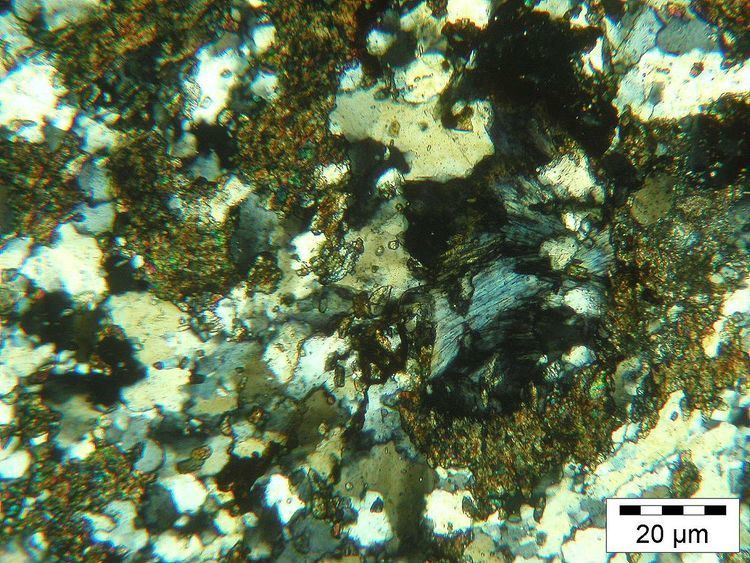Category Sorosilicates Crystal system Tetragonal | Strunz classification 9.BB.** Crystal habit Massive - granular | |
 | ||
Formula(repeating unit) (Ca,Na)2(Al,Mg,Fe)[(Al,Si)SiO7] Color Yellowish, greenish brown | ||
Melilite refers to a mineral of the melilite group. Minerals of the group are solid solutions of several endmembers, the most important of which are gehlenite and åkermanite. A generalized formula for common melilite is (Ca,Na)2(Al,Mg,Fe2+)[(Al,Si)SiO7]. Discovered in 1793 near Rome, it has a yellowish, greenish-brown color. The name derives from the Greek words meli (μέλι) "honey" and lithos (λίθους) "stone".
Minerals of the melilite group are sorosilicates. They have the same basic structure, of general formula A2B(T2O7). The melilite structure consist of pairs of fused TO4, where T may be Si, Al, B, in bow-tie form. Sharing one corner, the formula of the pair is T2O7. These bow-ties are linked together into sheets by the B cations. The sheets are held together by the A cations, most commonly calcium and sodium. Aluminium may sit on either the T or the B site.
Minerals with the melilite structure may show a cleavage parallel to the (001) crystallographic directions and may show weaker cleavage perpendicular to this, in the {110} directions. Melilite is tetragonal.
The important endmembers of common melilite are åkermanite Ca2Mg(Si2O7) and gehlenite Ca2Al[AlSiO7]. Many melilites also contain appreciable iron and sodium.
Some other compositions with the melilite structure include: alumoåkermanite (Ca,Na)2(Al,Mg,Fe2+)(Si2O7), okayamalite Ca2B[BSiO7], gugiaite Ca2Be[Si2O7], hardystonite Ca2Zn[Si2O7], barylite BaBe2[Si2O7], andremeyerite BaFe2+2[Si2O7]. Some structures formed by replacing one oxygen by F or OH: leucophanite (Ca,Na)2(Be,Al)[Si2O6(F,OH)], jeffreyite (Ca,Na)2(Be,Al)[Si2O6(O,OH)], and meliphanite (Ca,Na)2(Be,Al)[Si2O6(OH,F)]
New members of this mineral group were artificially grown and became intensively studied due to their multiferroic property, i. e. they simultaneously show ferroelectric and magnetic ordering at low temperatures. This gives rise to peculiar optical properties, for example Ba2Co(Ge2O7) shows giant directional dichroism (different absorption for counter-propagating light beams) and hosts magnetically switchable chirality.
Occurrences
Melilite with compositions dominated by the endmembers akermanite and gehlenite is widely distributed but uncommon. It occurs in metamorphic and igneous rocks and in meteorites.
Typical metamorphic occurrences are in high-temperature metamorphosed impure limestones. For instance, melilite occurs in some high-temperature skarns.
Melilite also occurs in unusual silica-undersaturated igneous rocks. Some of these rocks appear to have formed by reaction of magmas with limestone. Other igneous rocks containing melilite crystallize from magma derived from the Earth's mantle and apparently uncontaminated by the Earth's crust. The presence of melilite is an essential constituent in some rare igneous rocks, such as olivine melilitite. Extremely rare igneous rocks contain as much as 70% melilite, together with minerals such as pyroxene and perovskite.
Melilite is a constituent of some calcium- and aluminium-rich inclusions (CAIs) in chondritic meteorites. Isotope ratios of magnesium and some other elements in these inclusions are of great importance in deducing processes that formed our solar system.
